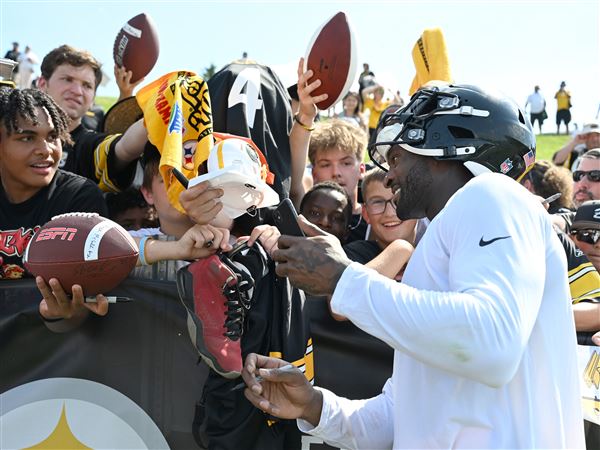BOSTON — Speaking in front of some of the smartest people in sports, Konstantinos Pelechrinis was making the case that it’s possible to quantify an abstract athletic asset: team chemistry.
Data skeptics would be cynical. Sure, you can analyze an outfielder’s defensive stats or a quarterback’s accuracy, but you can’t measure an intangible quality, like a player’s heart or grit, right?
“Well, sure we can’t — yet,” said Ben Alamar, the director of sports analytics at ESPN.
On Saturday morning, Mr. Pelechrinis, a faculty member at the University of Pittsburgh, presented his findings about team chemistry at the MIT Sloan Sports Analytics Conference. Mr. Pelechrinis, a 33-year-old native of Greece, was one of the finalists in the conference’s annual Hackathon.
The prestigious annual conference, organized by students at the Massachusetts Institute of Technology Sloan School of Management, brought together 3,500 certified sports geeks, including executives, statisticians, fans, journalists, students and hopeful future general managers.
Mr. Pelechrinis researches urban informatics — the study of networks, such as bike-share stations, in cities. So he applied the tools from that field to analyze a different kind of network: passing among players in five National Basketball Association games.
Broadly speaking, he found that a difference in teams’ ball movement (his proxy for team chemistry) correlated with a point differential between the competing squads. The finding was strong but not statistically significant because of the small sample size.
“What I found from the results is that these metrics, these complex systems, can somehow be used to describe team chemistry as it applies to successful teams,” said Mr. Pelechrinis, who teaches in Pitt’s School of Information Sciences.
While Mr. Pelechrinis did not win the Hackathon, his project was a highlight among the Pittsburgh cameos at the 11th annual conference, held on Friday and Saturday at Boston’s Hynes Convention Center.
A paper from the Pittsburgh lab of Disney Research, located at Carnegie Mellon University, came in second place out of more than 200 entries in the conference’s research paper competition.

Sam Ventura, left, a visiting assistant professor at Carnegie Mellon University and a consultant for the Penguins, spoke on a panel at the Sloan Sports Analytics Conference in Boston on Friday. (Photo courtesy of Sloan Sports Analytics Conference)
Sam Ventura, a CMU statistics faculty member who consults with the Penguins, spoke on a panel about in-game decision-making. Mt. Lebanon native Mark Cuban, the outspoken owner of the NBA’s Dallas Mavericks, participated in a lively discussion with data guru Nate Silver about Donald Trump, NBA officiating, Uber and a possible presidential candidacy. (”I’ll get back to you on that,” Mr. Cuban said.)
While the statistics experts for the Pirates and the Steelers, Dan Fox and Karim Kassam, did not attend this year’s conference, several sources credited Pittsburgh’s professional teams with being early adopters of data. As much as it pains many Steelers fans to hear, data show that coach Mike Tomlin is right to attempt two-point conversions frequently, Mr. Pelechrinis said.
“It kind of all started with the Pirates,” said Jarrod Blumer, a 23-year-old Robert Morris University alumnus who attended the conference. “They got into the sabermetrics and into the defensive shifts, and they got known for that, and with the Penguins hiring Sam, that was kind of the next step.”
Much of the Pittsburgh-based activity in the young, dynamic field of sports analytics has taken place since the beginning of the decade. A handful of academics connected to CMU have joined the staffs of professional sports teams, including Mr. Ventura and former faculty member Andrew Thomas, now the lead hockey researcher for the Minnesota Wild.
“In my first year of grad school at CMU, which was in 2010, I took a sports analytics seminar from Andrew, where we just sort of read papers and brainstormed ideas of how could we improve the methodology used here if we wanted to,” Mr. Ventura, 29, said.
That led to further activity: Mr. Thomas and Mr. Ventura held a conference in Pittsburgh on hockey analytics in 2014 and launched a website, WAR On Ice, devoted to the subject. The Tartan Sports Analytics Club was established in 2013.
Mr. Thomas said he met Pittsburgh native Ben Resnick, the Wild’s manager of hockey administration, at a previous Sloan conference.
Others, however, have contributed to the field from outside the pro sports setting. The award-winning paper from Disney Research looked at the use of computers to detect when soccer players were out of position. The project drew on the same technologies, including sensors, machine learning and artificial intelligence, that appear in Uber’s self-driving cars, research scientist Peter Carr said.
“It’s great to be able to apply those technologies to sports data, as well,” said Mr. Carr, 37. “In sports, the underlying objectives are a lot easier to infer. Teams want to win, so it’s almost easier to work on than a generic problem in the wild.”
The sports analytics community — centered on CMU and the professional teams — has expanded to other institutions in Pittsburgh. Mr. Pelechrinis hopes to establish a sports analytics program at Pitt’s School of Computing and Information, opening this summer, and he created a speaker series on the subject, which is open to the public.
Mr. Blumer persuaded RMU men’s ice hockey to bring him on as a hockey operations intern last season, and he still consults with the team, even after starting a master’s at the University of Oklahoma in the fall.
It seems certain that the applications of sports analytics will continue to rise, in Pittsburgh and elsewhere. More than just tracking players, the field encompasses a wide variety of areas, from injuries to in-stadium fan experiences, conference co-founder Daryl Morey said.
Sloan has both followed the growth of sports analytics and facilitated it. Since the conference was established, NBA teams are taking more 3-point attempts, and National Football League teams are passing with more frequency, issues that were discussed at Sloan in previous years.
On Friday, the conference held a panel called “Football Analytics: Please Stop Punting.” The title refers to data showing that NFL teams should more consistently “go for it” on fourth down.
So, if the Steelers punt less in the coming years, don’t be surprised. Just take comfort in the fact that they have data on their side.
Elizabeth Bloom: ebloom@post-gazette.com, 412-263-1750 and Twitter: @BloomPG.
First Published: March 6, 2017, 5:00 a.m.
















